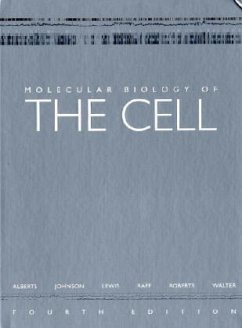Table of contents:
1. Introduction to Cells 2. Chemical Components of Cells 3. Energy, Catalysis, and Biosynthesis 4. Protein Structure and Function 5. DNA and Chromosomes 6. DNA Replication, Repair and Recombination 7. From DNA to Protein: How Cells Read the Genome 8. Control of Gene Expression 9. How Genes and Genomes Evolve 10. Manipulating Genes and Cells 11. Membrane Structure 12. Membrane Transport 13. How Cells Obtain Energy from Food 14. Energy Generation in Mitochondria and Chloroplasts 15. Intracellular Compartments and Transport
16. Cell Communication 17. Cytoskeleton 18. Cell-Cycle Control and Cell Death 19. Cell Division 20. Genetics, Meiosis, and the Molecular Basis of Heredity 21. Tissues and Cancer
‘Essential Cell Biology’, Second Edition contains basic, core knowledge about how cells work. It has a proven track record in providing students with a conceptual and accessible grounding in cell biology. The text and figures have been prepared to be easy-to-follow, accurate, clear and engaging for the introductory student. Each section follows logically from the previous one, telling a story, rather than being a collection of facts. Questions integrated throughout each chapter encourage the reader to pause, think about what they have read, and attempt to apply the new knowledge in ways that test their understanding. Based on user feedback, the Second Edition now offers increased coverage of genetics and more experimental background. It is completely up-to-date.
‘Molecular Biology of the Cell’ is the classic in-depth text reference in cell biology. By extracting fundamental concepts and meaning from this enormous and ever-growing field, the authors tell the story of cell biology, and create a coherent framework through which non-expert readers may approach the subject. Written in clear and concise language, and illustrated with original drawings, the book is enjoyable to read, and provides a sense of the excitement of modern biology. ‘Molecular Biology of the Cell’ not only sets forth the current understanding of cell biology (updated as of Fall 2001), but also explores the intriguing implications and possibilities of that which remains unknown.
The hallmark features of previous editions continue in the Fourth Edition. The book is designed with a clean and open, single-column layout. The art program maintains a completely consistent format and style, and includes over 1,600 photographs, electron micrographs, and original drawings by the authors. Clear and concise concept headings introduce each section. Every chapter contains extensive references. Most important, every chapter had been subjected to a rigorous, collaborative revision process where, in addition to incorporating comments from expert reviewers, each co-author reads and reviews the other authors' prose. The result is a truly integrated work with a single authorial voice.
‘Molecular Biology of the Cell ‘is the classic in-depth text reference in cell biology. Written in clear and concise language, and beautifully illustrated, the book is enjoyable to read, and it provides a clear sense of the excitement of modern biology.
1. Introduction to Cells 2. Chemical Components of Cells 3. Energy, Catalysis, and Biosynthesis 4. Protein Structure and Function 5. DNA and Chromosomes 6. DNA Replication, Repair and Recombination 7. From DNA to Protein: How Cells Read the Genome 8. Control of Gene Expression 9. How Genes and Genomes Evolve 10. Manipulating Genes and Cells 11. Membrane Structure 12. Membrane Transport 13. How Cells Obtain Energy from Food 14. Energy Generation in Mitochondria and Chloroplasts 15. Intracellular Compartments and Transport
16. Cell Communication 17. Cytoskeleton 18. Cell-Cycle Control and Cell Death 19. Cell Division 20. Genetics, Meiosis, and the Molecular Basis of Heredity 21. Tissues and Cancer
‘Essential Cell Biology’, Second Edition contains basic, core knowledge about how cells work. It has a proven track record in providing students with a conceptual and accessible grounding in cell biology. The text and figures have been prepared to be easy-to-follow, accurate, clear and engaging for the introductory student. Each section follows logically from the previous one, telling a story, rather than being a collection of facts. Questions integrated throughout each chapter encourage the reader to pause, think about what they have read, and attempt to apply the new knowledge in ways that test their understanding. Based on user feedback, the Second Edition now offers increased coverage of genetics and more experimental background. It is completely up-to-date.
‘Molecular Biology of the Cell’ is the classic in-depth text reference in cell biology. By extracting fundamental concepts and meaning from this enormous and ever-growing field, the authors tell the story of cell biology, and create a coherent framework through which non-expert readers may approach the subject. Written in clear and concise language, and illustrated with original drawings, the book is enjoyable to read, and provides a sense of the excitement of modern biology. ‘Molecular Biology of the Cell’ not only sets forth the current understanding of cell biology (updated as of Fall 2001), but also explores the intriguing implications and possibilities of that which remains unknown.
The hallmark features of previous editions continue in the Fourth Edition. The book is designed with a clean and open, single-column layout. The art program maintains a completely consistent format and style, and includes over 1,600 photographs, electron micrographs, and original drawings by the authors. Clear and concise concept headings introduce each section. Every chapter contains extensive references. Most important, every chapter had been subjected to a rigorous, collaborative revision process where, in addition to incorporating comments from expert reviewers, each co-author reads and reviews the other authors' prose. The result is a truly integrated work with a single authorial voice.
‘Molecular Biology of the Cell ‘is the classic in-depth text reference in cell biology. Written in clear and concise language, and beautifully illustrated, the book is enjoyable to read, and it provides a clear sense of the excitement of modern biology.

